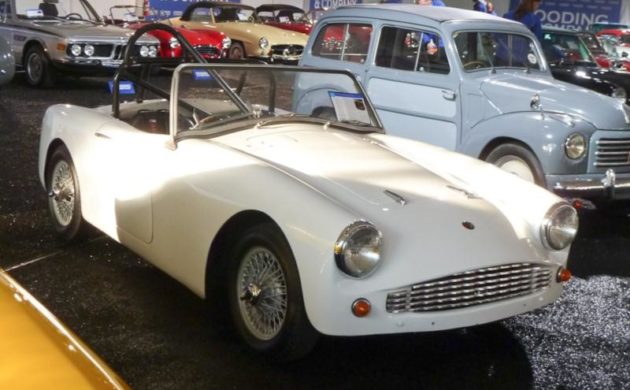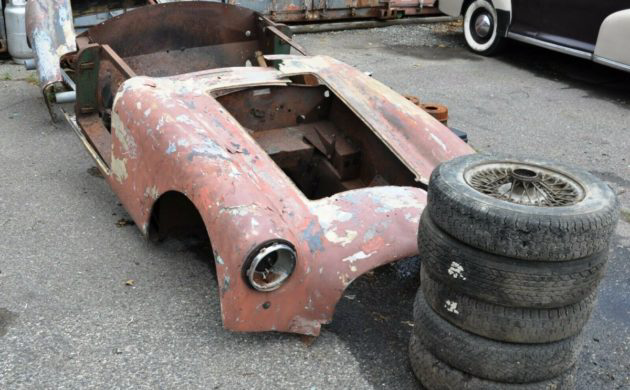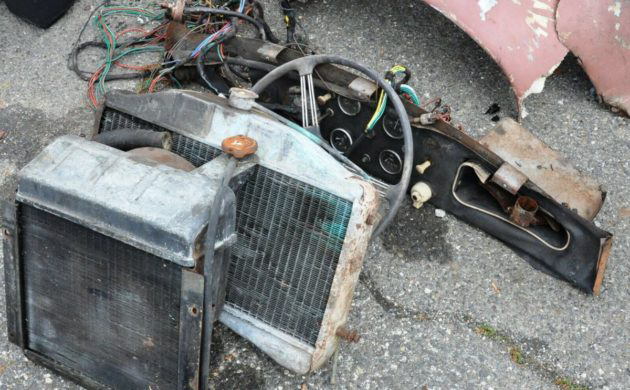This pile of parts is the once-glorious remains of a Turner 950 Sports kit car that is being offered as an incomplete project or a treasure trove of parts for another Turner closer to road-going form. The Turners are another example of a British brand that took advantage of parts bin mechanicals to build a track-friendly kit for the DIY crowd. However, Turner also developed its own engines, which makes it a bit of an anomaly in the vintage kit car market. This offering here on eBay includes two chassis, including one supposedly bought just before Turner closed its doors for good, and one steel and one fiberglass body structure. Bidding is at just $610 with no reserve.
I have to wonder if vintage kit cars built for track use is an industry we’re sleeping on, as these cars generally performed well and allowed owners to increase performance capabilities with relative ease. Unfortunately, the obscurity factor sometimes hinders their value, as the cars were typically made in such limited quantities that it’s difficult to establish a baseline on price. Some models that come to mind include the Sylva Phoenix, the GP Spyder, the Ginetta G4, and the Westfield X1. All very capable performers in the right hands, and some more valuable than others simply because they’re more visible in the vintage racing scene.
So then the question becomes: could you built a competent race car out of the parts available through this listing? The seller notes that there’s not quite enough to build one entire car, but it’s close. Some of the major systems noted as having “most but not all” of the necessary parts include the front suspension, brake system, and wiring harness. The lot includes a disassembled 950 BMC A series engine and a complete and assembled BMC A-series 4-speed synchro rib case transmission. As you can see here, a dash with gauges and a radiator is also included, but all parts will likely need to be rebuilt or restored.

Turner made a few different variations of its primary models, and I believe this is a finished example of what a 950 would look like. Not bad, right? This is another area wherein I don’t exactly understand how the American version of a similar industry varied so wildly with what its European counterparts were doing. Plenty of British manufacturers used VW-based kits like domestic builders did, but while we were building dune buggies and Bradley GTs, the Brits were cranking out competent road course cars. While finding the necessary spares will likely be a tall order, kit cars like this Turner at least allow the flexibility to finish the car as you see fit to get it back on the road.





Looks like you could pick up a late 60’s Midget or Sprite and you would have the rest of the parts. Wish I had the space for this puzzle.
The US kit car industry arose from the desire to capitalize on the rusted out Beetles that were piling up everywhere. The British kit car industry was a reaction to tax law, where owner-assembled cars were taxed less than complete cars.
The reason they were sports cars is because they were far more affordable for Brits than all the Austin-Healeys, MGs, and Triumphs. If you look at the production and export numbers on those cars, you’ll see that they existed to address the UK’s mercantilist view of their balance of payments. Manufacturers had to export to get allotments of raw materials, and sports cars were far more appealing to US buyers than the austere sedans they were based on. Mass produced sports cars were all about they UK getting its hands on US dollars after the war. The kits allowed Brits to have a semblance of what their country was peddling to Americans.
Chances are that a home-built combination of Austin A30 spares and a Turner frame required a much smaller outlay than buying a new Sprite in the UK. If you couldn’t afford the whole Turner kit, you could make your own body or get a cheap fiberglass one from a number of suppliers.
I’m a big fan of Turners, having once followed their antics into the ’90s in SCCA production classes. Cool cars. I hope this part hoard finds its way to someone who makes good use of it.
That’s some interesting history, CJinSD. Thank you for sharing an aside of automotive history that many of us I’ll bet never gave a second thought.
Is the Caterham 7 version of the Lotus 7 then in the genre of building an affordable British sports car or were they just in the right place at the right time to continue a popular machine?
The Lotus 7 may have been the car that kicked off the British kit car movement in 1957. In 1963, Ron Champion designed a similar car, and eventually you could even buy a book about how to build a “Locost” of your own. A cottage industry grew up around the Ron Champion design, and one could buy a pre-welded chassis or some bodywork from a number of suppliers. The Lotus 7 was meant to be inexpensive, but it was still more expensive than building one to Locost plans. In 1968, Lotus launched the Series 4 Lotus 7, which combined dune-buggy-esque fiberglass bodywork with the traditional Lotus 7 frame. Demand dropped off at the same time that Colin Chapman wanted to take his company up-market to compete with Porsche and Dino. The Caterham guys had a Lotus dealership and for years much of their volume had been with the low-end 7, so they didn’t want it to go away. Chapman sold them the tooling and rights in 1972 or 1973, initially for the Series 4. Demand remained flat so they reverted to the Series 3 design and the demand came back. Initially, they were still fairly affordable, but the British sports car export moment had really passed by then.
Ron Champion’s book, “Build Your Own Sports Car for as Little as £250 and Race It!,” had taken over the low end of the market and Caterhams devolved into track-day toys for people who worked in finance exporting the jobs of the people who once built cars to avoid new car taxes.
Devin, La Dawri, Victress, Glaspar et al preceded the VW based kit car boom.
Weren’t they primarily the work of guys playing with fiberglass technology to create car bodies that required owners to do everything from cutting and engineering doors and windows to building frames?
“The British kit car industry was a reaction to tax law, where owner-assembled cars were taxed less than complete cars.”
It´s not really the case. The first cars in the 50s were a product of austerity. They were sports cars because there was a cottage industry of little English racing car manufacturer who used Austin 7 and Ford Sidevalve chassis/running gear to build their dreams. Lotus, Marcos, Lola,and Ginetta all started this way.
The tax advantage became more important in the 60s, when Lotus, Marcos, Turner, could supply you with a complete new car, all new components, delivered to your house for final assembly. It saved about 20% purchase tax to do it this way, but tax change to VAT in about 1973 killed the loophole.
Turner was a very successful car in UK and US sports car racing, so this will be useful to someone who is already racing. It´s an earlier type than your “finished” 950, a bit less attractive. Of the “examples which come to mind” in the text, only Ginetta G4 is eligible for vintage racing. Lucky enough to have one myself!
There’s a wealth of Turner information available at one’s fingertips thanks to the good ol’ (well it’s old now) cat and kitten created interwebs, Let’s begin with a 950 #30/044 with a unique history that was taken delivery at the Wolverhampton works with Jack Turner handing over the keys to T.E.G Fonseka of Sri Lanka. With his UK studies completed Dr Fonseka returned to Sri Lanka to become Professor of Public Health and conductor of the country’s Symphony Orchestra. Of course he took his early 950 to Sri Lanka when he repatriated and it’s been restored though now painted white and fitted with bolt on wire wheels.
The full story with photos including Petula Clark and her 950 1PBC:
https://defonseka.com/front-page/the-articles/articles/the-forgotten-car/
For more of the wealth of information mentioned earlier, click on the Turner Sports Car Registry link at the bottom of the page reference (3). The story of the first US importer, Tri City Sports Cars of Massillon, Ohio deserves a read.
That’s a great looking body – much more attractive than some of the kit car oddities out there. The front end reminds me of the BMW 507.
@ CJinSD
Actually I beg to politely differ with you.
The kit car industry was started by Collin Chapman with the Lotus 6 and 7.
The main motivation was the avoidance of car excise duty by supplying cars in kit form. You’re talking about a 30 to 40 % reduction in price.
Most of the mass produced small sports cars such as the Healey Sprite and MG Midget were quite economical compared to the kit cars – that is until you added the exorbitant excise tax.
The problem persisted right into the 2000’s, when it was fashionable for the Brits to cross the channel to buy their cars. It was one of the many contributing reasons for the eventual collapse of the British car industry.
Just love the way Politicians can manage to wreck industry with their interfering ways.
It’s about to happen all over again with this idiocy over EV vehicles in Europe ……
Sorry if this is a douuble post, but my original didn´t seem to go through.
Likke I mentiooned above, it´s a lot more accidental than you suggest, Peter. There are 3 phases of small British fibreglass sports cars. The first was in a bankrupot post war Britain, using second hand parts from Austin 7 and Ford sidevalve. Pioneers were Buckler and Bellamey. Tax had nothing to do with this as the end product was a second hand car, but Lotus, TVR, Ginetta, Marcos all started down this route.
Chapman was an early adopter of the second phase, mid 50s to about 1973 of componentr cars (Lotus 6 , Elite, Elan, Europa, etc). These were all new CKD cars delivered to your house with all new components and full factory warranty. This was a tax-driven, as it saved ppurchase tax (more like 20% than 40%, but substantial) and Lotus, Marcos, TVR, Gilbern,Ginettaetc all did this. Turner was an early adopter. Changes in tax laws closed the loophole about 1973.
The third (still current) phase was more similar to the first phase, buying a kit and buildiing a car around your own components and started with Beach Buggies in the late 60s. This is the model for Westfield, Sylkva, Cobra and Porsche replicas etc still popular today.
It´s true that Sprites/Spitfires were much cheaper, but that´s more about mass production. They were about 700GBP after tax when a Ginetta G15 CKD kit would have cost about 150GBP more and you have to build it yourself.
Brits used to buy cars in NL/Belgium/Ireland because the dealers in UK could charge inflated prices, so it was cheaper to import grey market. This stopped in early 21st Century when EU legislation was introduced to protect the consumer.
Turners are really small. Hard to visualize without a person in the photos. I’ve seen a couple at shows and they appear smaller than a Sprite but the proportions are so good you don’t notice in pictures of the car only.
These are absolutely wonderful vehicles.
Where to start… The early Turner 950’s are based on Sprite running gear, and have a oval top egg create grill. The later models, MKI, MKII, and MKIII continued the A-series engines, but the later used Ford.(The white photo at the end of this review is a MK I or MK II, not a 950). Turner only made a couple of engines, early on. . Turners are often raced, along with period Ginetta G4’s.. The Sylva Phoenix, GP Spyder, and Westfield X1 are all later productions / replicas, and wouldn’t be eligible in many vintage racing orgs. See the more complete Turner story and model range at http://www.turnersportscars.co.uk/
I have several Turners, including 3 from a recently retired vintage racer. One very nice, one good (with Ford engine), and one rough. The rough one would meld nicely with these parts, or can be restored on itxs own.
Does anyone have an idea of how to contact the person who bought these parts? Thanks, Hank 757 375 1491 VA.